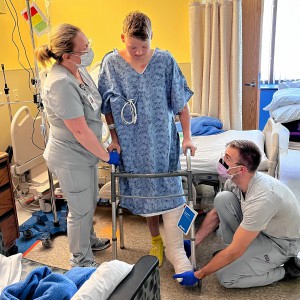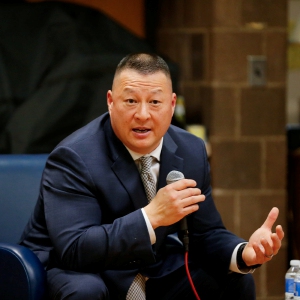Exploring mill past to build a future
| Published: 01-02-2023 11:28 AM |
Scattered throughout the woods of Leverett are clues, both large and small, of an industrial past the town has left behind as the world around it developed and further modernized.
And scattered throughout the last three years have been presentations put on by the Leverett Historical Commission to share this knowledge with residents, while helping inform future preservation discussions. In the ongoing series, “A Sense of Where You Are, Finding and Interpreting Mill Foundations in the Landscape,” folks are invited to learn about Leverett’s industrial history and learn more about the place they call home.
Beginning with a survey of residents in 2018 that asked folks about their interest in the history of their town, the Historical Commission has built up a multi-year program — with in-person and Zoom events once the pandemic began — that has brought these histories to light with historical analysis of town records and site visits.
“A lot of understanding why Leverett is the way it is today has to do with the way it was built through these industries,” said Leverett Historical Commission Chair Susan Mareneck. “We call this whole program, ‘A Sense of Where You Are,’ because so many people are transplants into our town and they told us in the survey that they loved learning the history of some of these places.”
A prime example of how Leverett grew around its industries, Mareneck noted, is how the town’s villages were all developed around different sources of water power, which fueled the mills and kilns producing farm implements and charcoal goods.
Pleun Bouricius, a consultant for the Historical Commission, said Leverett had several small but “thriving industries” on its rivers in the 18th and 19th centuries, and signs of those mills, specifically the foundations, can still be found today.
While mill foundations are typically what remains of many of these structures, some of the work done around them is still visible. Following town records, such as deeds and land transfers, and using light detection and ranging (LIDAR) scans, the Historical Commission locates structures including levees, dams and other “elaborate” water-diversion measures.
“It’s just so smart,” Bouricius said of how these small-town industries were able to adapt and use the environment around them. “It looked like a draft for Lowell or Holyoke, even though it was happening at the same time.”
Article continues after...
Yesterday's Most Read Articles
 Political newcomer defeats Shores Ness for Deerfield Selectboard seat
Political newcomer defeats Shores Ness for Deerfield Selectboard seat
 Granby Bow and Gun Club says stray bullets that hit homes in Belchertown did not come from its range
Granby Bow and Gun Club says stray bullets that hit homes in Belchertown did not come from its range
 Annette Pfannebecker: Vote yes for Shores Ness and for Deerfield
Annette Pfannebecker: Vote yes for Shores Ness and for Deerfield
 Susan Tracy: Support Ukraine funding
Susan Tracy: Support Ukraine funding
 Around Amherst: Bockelman joins in launch of governor’s housing push
Around Amherst: Bockelman joins in launch of governor’s housing push
 Defying the odds: Hadley’s Owen Earle back competing less than two years removed from horrific accident
Defying the odds: Hadley’s Owen Earle back competing less than two years removed from horrific accident
An example of this work is Graves Ironworks, formerly located near the North Leverett Sawmill, which produced scythes and their handles in the 19th century. The site, between two currently standing mills, showcases the density of industries at that point in the town’s history and while the mill pond — a reservoir used to power water wheels — no longer exists, the levees and dams that formed it are still standing, according to a presentation given by the Friends of the North Leverett Sawmill to the Selectboard in October.
All the work for this ongoing series has been worthwhile, as Bouricius said a quarter of all households in Leverett have participated in at least one in-person or Zoom presentation.
“It’s really been awesome and Zooming the programs has really extended the reach,” Bouricius said. “We’re now embarking on two new programs and we are creating some more community collaboration.”
The first of those two new programs is a historical signage initiative, which the Historical Commission hopes will identify some of these historic sites around town. The second is a new series of presentations centered around “embodied history” where the Commission will seek out people who worked in the charcoal or mill industries and talk about their experiences and compare them to historical descriptions.
The Historical Commission expects its Embodied History program to kick off in early February and those interested should keep an eye on the Commission’s website: leverett.ma.us/g/52/Historical-Commission.
Historical Commission member Eva Gibavic, who takes on a good chunk of the research, including the LIDAR scans, said the overarching goal of these programs, beside providing interesting information to residents, is to encourage historical preservation of these sites. She added her mother, who was also involved with the Historical Commission, said the most important thing is to “learn from our ancestors because it will give us strength.”
“I think that’s really important to understand — who came here, who was here before white settlers came here and what this place we call Leverett is about,” Gibavic said. “Things really change, and when you understand who you are and who you came from … it’s fascinating.”
Mareneck added the informational aspect serves as a way to draw people into their town’s history and can spur preservation discussions.
“It brings perspective to us as we sort out the future for Leverett. What is the balance of protection and, what they call in preservation, adaptive re-use?” Mareneck said. “We hope that by educating ourselves and each other about these assets we have, we’ll be better positioned to preserve … and when that can happen in a way that pleases the community, it’s a win-win.”
An example of reuse for these locations has been proposed for the Graves Ironworks site. In the Friends of the North Leverett Sawmill’s presentation, the group laid out ideas for a heritage park and nature trail on the site, which would run through the North Leverett Sawmill’s land — owned by the Friends — and through the Graves mill, which is owned by the town.
Mareneck said the trail could provide an educational experience with signs about Indigenous peoples’ use of the site, as well as a creating an area for natural flora to thrive, while allowing access to a historical location. The preservation of the site, Mareneck noted, is not entirely straightforward, as trees have been threatening the levee’s stones, leaving the town with a decision over what to preserve.
“Now the question is, do you preserve the trees or the levee? … It’s gotten very interesting, ” Mareneck said. “We don’t know what ‘should’ be done; we’re figuring it out as we go, in partnership with the owners of these properties.”
Video recordings of previous presentations can be found on Gibavic’s YouTube page here: youtube.com/@EvaDeva1000/videos.
Chris Larabee can be reached at clarabee@recorder.com or 413-930-4081.

 Sharing a few notes: High schoolers coaching younger string players one on one
Sharing a few notes: High schoolers coaching younger string players one on one Reyes takes helm of UMass flagship amid pro-Palestinian protests
Reyes takes helm of UMass flagship amid pro-Palestinian protests Sole over-budget bid could doom Jones Library expansion project
Sole over-budget bid could doom Jones Library expansion project Amherst poised to hire police department veteran as new chief
Amherst poised to hire police department veteran as new chief 